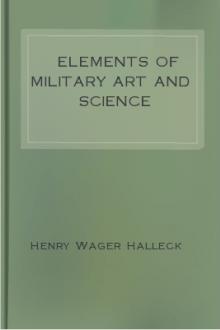Elements of Military Art and Science by Henry Wager Halleck (books you have to read txt) 📕

- Author: Henry Wager Halleck
- Performer: -
Book online «Elements of Military Art and Science by Henry Wager Halleck (books you have to read txt) 📕». Author Henry Wager Halleck
The bayonet was introduced by Vauban in the wars of Louis XIV., and after the years 1703 and '4, the pike was totally suppressed in the French army. This measure was warmly opposed by Marshal Montesquieu, and the question was discussed by him and Marshal Vauban with an ability and learning worthy of these great men. The arguments of Vauban were deemed most conclusive, and his project was adopted by the king.
This question has been agitated by military writers in more recent times, Puységur advocating the musket, and Folard and Lloyd contending in favor of restoring the pike. Even in our own service, so late as the war of 1812, a distinguished general of the army strongly urged the use of the pike, and the fifteenth (and perhaps another regiment) was armed and equipped in part as pikemen; but experience soon proved the absurdity of the project.
Napoleon calls the infantry the arm of battles and the sinews of the army. But if it be acknowledged, that, next to the talent of the general-in-chief, the infantry is the first instrument of victory, it must also be confessed that it finds a powerful support in the cavalry, artillery, and engineers, and that without these it would often be compromised, and could gain but a half success.
The French infantry is divided into one hundred regiments of three battalions each, a battalion being composed of seven companies. There are also several other battalions of chasseurs, zuaves, &c., being organized especially for service in Africa, and composed in part of native troops.
In our own army we have eight regiments of infantry, each regiment forming a single battalion of ten companies. The flank companies are intended for light infantry.
In all properly organized armies the infantry constitutes from three-fourths to four-fifths of the entire active force in the field, and from two-thirds to three-fourths, say about seven-tenths of the entire military establishment. In time of peace this proportion may be slightly diminished.
Cavalry.—The use of cavalry is probably nearly as old as war itself. The Egyptians had cavalry before the time of Moses, and the Israelites often encountered cavalry in their wars with their neighbors, though they made no use of this arm themselves until the time of Solomon.
The Greeks borrowed their cavalry from the Asiatics, and especially from the Persians, who, according to Xenophon, held this arm in great consideration. After the battle of Platea, it was agreed by assembled Greece that each power should furnish one horseman to every ten foot-soldiers. In Sparta the poorest were selected for this arm, and the cavalry marched to combat without any previous training. At Athens the cavalry service was more popular, and they formed a well-organized corps of twelve hundred horsemen. At Thebes also this arm had consideration in the time of Epaminondas. But the cavalry of Thessaly was the most renowned, and both Philip and Alexander drew their mounted troops from that country.
The Romans had made but little progress in this arm when they encountered the Thessalians, who fought in the army of Pyrrhus. They then increased their cavalry, but it was not numerous till after their wars with the Carthaginians. Scipio organized and disciplined the Roman cavalry like that of the Numidians. This arm was supplied from the ranks of the richest citizens, and afterwards formed an order intermediary between the Senate and the people, under the name of knights.
At a later period, the cavalry of the Gauls was particularly good. The Franks were without cavalry when they made their first irruption into Gaul. Under the reign of Childeric I. we see for the first time the "cavaliers francs" figure as a part of the national forces. At the battle of Tours the cavalry and infantry were in the proportion of one to five, and under Pepin and Charlemagne their numbers were nearly equal. Under Charles the Bald armies were composed entirely of cavalry, and during the middle ages the knights disdained the foot service, and fought only on horseback.
After the introduction of artillery, cavalry was still employed, though to little advantage. Gustavus Adolphus was the first to perceive the real importance of this arm in modern warfare, and he used it with great success. But it was left for Seidlitz to perfect it under the direction of Frederick the Great.
Marshal Saxe very justly remarked, that cavalry is the "arme du moment," for in almost every battle there are moments when a decisive charge of cavalry will gain the victory, but if not made at the instant it may be too late. The efficiency of cavalry depends upon the moral impression which it makes on the enemy, and is greater in proportion to the size of the mass, and the rapidity of its motion. This last quality enables a commander to avail himself immediately of a decisive moment, when the enemy exposes a weak point, or when disorder appears in his ranks. But this requires a bold and active spirit, which shrinks not from responsibility, and is able to avail itself with quickness and decision of every opportunity. If it be remembered that it is essential that this coup d'oeil, so rare and so difficult to acquire, be accompanied by a courage and vigor of execution which nothing can shake, we shall not be astonished that history furnishes so few good cavalry generals, and that this arm so seldom does such execution as it did under Frederick and Napoleon, with Seidlitz and Murat as commanders.
The soldier gains great velocity by the use of the horse in war; but in other respects he is the loser. The great expense and care required of the cavalier to support his horse; the difficulty experienced in surmounting ordinary obstacles, and in using his fire-arms to advantage, are all prejudicial to success.
The unequal size of the horse, and the great diversity in his strength and breed, have rendered it necessary to divide this arm into light and heavy cavalry, and a mixed class called dragoons. The heavy cavalry is commonly used in masses where force is mainly requisite; the lighter troops are used singly and in small detachments, where rapidity of movement is most desired.
The heavy cavalry are divided into carabiniers, cuirassiers, and sometimes lancers. The two latter are frequently united, the cuirassiers being armed with the lance. These troops are seldom used for scouts, vanguards, and convoys; but are frequently employed to sustain the light cavalry. Their main duty is "to appear on the field of battle and make the decisive charges."
The light cavalry is composed of chasseurs, or troopers, hussars, and lancers. The latter, when composed of large men and mounted on heavy horses, are attached to the heavy cavalry.
The dragoons were formerly a mixed body of horse and foot, but it being found impossible to unite these two distinct arms in one, and the attempt having destroyed the usefulness of the body to act in either capacity, the term was applied to a mixed kind of cavalry between the heavy and the light horse. In more recent wars they have also been instructed as infantry and employed as foot-soldiers, till horses could be found in the enemy's country with which to mount them. But we believe there is no instance in more modern wars in which they have been employed at the same time in both capacities.
This term is, very improperly, applied to all our cavalry; and some of the congressional wiseacres have recently experimented on one of our so-called regiments of dragoons, by dismounting it one year, selling its horses at auction, and changing its arms and equipments, and again, the next year, purchasing new horses, arms, and equipments for remounting it; and all this for economy!
The Roman cavalry at first wore a round shield and helmet, the rest of their body being nearly uncovered. Their arms were a sword and long thin javelin, or lance, with an iron head. They afterwards reduced the shield to a much smaller size, and made square, and their lance was greatly increased in size and length, and armed at both ends. In other respects they were armed in the same way as infantry. The use of the lance and the shield at the same time, of course rendered both nearly worthless. The Roman cavalry was superior to that of their enemies, except, perhaps, the light cavalry of the Parthians.
The heavy armor which was sometimes worn by the ancients, like the gens d'armes of the middle ages, rendered them greatly inferior to infantry in a close engagement. Tigranes, king of Armenia, brought an army of one hundred and fifty thousand horse into the field, against the Roman general Lucullus, who had only about six thousand horse and fifteen thousand foot. But the Armenian cavalry, called cataphratti were so overburdened with armor, that when they fell from their horses they could scarcely move or make any use of their arms. They were routed by a mere handful of Roman infantry.
The modern cavalry is much lighter, and, by dispensing with armor, shields, &c., it can move with much greater rapidity. A modern cavalry horse carries a weight of from two hundred and fifty to three hundred pounds, viz.:
Heavy Cavalry Light Cavalry The rider 160 140 lbs. His arms and equipments 55 40 His horse equipments 60 45 Two days' rations of provisions and grain 25 25 300 250The horse moves per minute—
At a walk, from 110 yards to 120
At a trot, 220 240
At a gallop, 330 360
But on a march over the ordinary average of good and bad roads, cavalry will walk about one hundred yards per minute, and at an easy trot, two hundred.
An ordinary day's march for cavalry is about thirty miles, but on a forced march this arm can march fifty miles within the twenty-four hours. A single horseman, or a small detachment, can easily exceed this distance.
"Light cavalry," says Napoleon, in his Memoirs, "ought to reconnoitre and watch the motions of the enemy, considerably in advance of the army; it is not an appendage to the infantry: it should be sustained and protected especially by the cavalry of the line. Rivalry and emulation have always existed between the infantry and cavalry: light cavalry is indispensable to the vanguard, the rearguard, and the wings of the army; it, therefore, cannot properly be attached to, and forced to follow the movements of any particular corps of infantry. It would be more natural to attach it to the cavalry of the line, than to leave it in dependence upon the infantry, with which it has no connection; but it should be independent of both."
"If the light cavalry is to form vanguards, it must be organized into squadrons, brigades, and divisions, for the purpose of manœuvring; for that is all vanguards and rearguards do: they pursue or retreat by platoons, form themselves into several lines, or wheel into column, or change their position with rapidity for the purpose of outfronting a whole wing. By a combination of such evolutions, a vanguard,





Comments (0)